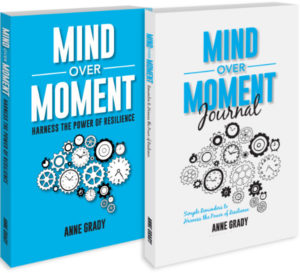The Greek lyrical poet Archilochus once said, “We don’t rise to the level of our expectations, we fall to the level of our training.” Take that a step further. You don’t rise to the level of your intentions, you fall to the level of your habits.
Get to Know Your Habits
When you are stressed, tired, or under pressure, you are more likely to fall back on habitual patterns of thinking and behaving. But do those habits serve you? Will they help you create the life you want?
Your brain loves habits because it doesn’t have to work as hard. Even negative habits are more comfortable than new ones. Once you start recognizing patterns, you can make intentional choices about the habits you choose to maintain and adopt. This is the basis of my Mind Over Moment book and strategy.
A habit is something that once required conscious effort but has become automatic. It turns out, a large portion of what you do each day is a habit. In fact, more than 45% of what you do every single day is a habit. Your brain depends on these cognitive shortcuts to conserve energy. If you have ever driven home on autopilot because you were deep in thought, you were operating out of habit.
You live almost half your life on autopilot. If you are not careful, you can become a slave to your habits, and they can become a way to unconsciously live your life, rather than deliberately choosing what you want and creating a path to get there.
Habits can be super helpful. After all, if you had to think really hard about putting on shoes, eating, taking a shower, or getting dressed, you would be exhausted by 9 a.m. Your habits allow you to conserve mental energy.
- Have you ever been to the grocery store after they have rearranged the shelves?
- For the love of Pete, where’d they put the peanut butter?
- Why is it so exhausting hunting for items you used to know were on aisle 11?
Even without realizing it, when you plan your trip to the store, you visualize what you need in each of the aisles because you know where things are. Your brain has a map, basically a neural network that gets more deeply etched the more you think or do something. This makes it much easier to think or do the things you have always thought and done.
Unfortunately, your brain doesn’t know the difference between a good habit and a bad habit. It doesn’t know the difference between being anxious, worried, and fearful or optimistic, excited, and grateful. It doesn’t know the difference between getting home from work and drinking a bottle of wine or going to the gym. Your brain just takes anything you repeatedly think, say, or do, and converts it into a habit.
Take a second to try something:
- Cross your arms like you are cold or angry.
- Now cross them in the opposite direction.
Which way feels more awkward? When you crossed your arms the first time, the signal came from your limbic system. It’s a habit—you’ve done it a million times, and you didn’t even have to think about it. The second time you crossed your arms, the signal came from your prefrontal cortex. It was probably a little odd, clunky, and uncomfortable, and you had to think about it. If you practice crossing your arms in that direction regularly, eventually that will become a habit too.
Building resilience requires that you be deliberate about your habits. It means you must challenge your automatic thoughts and behaviors, and that is hard work. When it comes to your life, personally and professionally, what habits are supporting your success, and which habits are sabotaging it?
There is no timetable for habit change. Your neural pathways have been carved deeply, and it takes repetitive, consistent change to build new neural pathways. And just because you develop a new neural pathway does not mean old ones are erased—which means it’s easy to slip back into old habit patterns.
Think of your brain like a field full of grass. You can walk through the field, but the grass will still pop back up. You may have to walk in the exact place a hundred times before a pathway is carved. And just because you carve new pathways doesn’t mean the old ones aren’t still well-worn and comfortable. Old bumpy paths that we know can be more comfortable than the smooth ones we don’t. To change habit patterns, you have to be willing to get comfortable being uncomfortable.
Shift Your Mental Habits
If I let my mind go where it wants to naturally, I am likely to ruminate on the negative. I second guess myself, question my own decisions, and regret things I’ve said or didn’t say. I should have… I could have… I wish I would have. I could spend all day “shoulding” on myself if I’m not careful. It has become a habit, and it is one I’m working to change. Practicing Mind Over Moment means that I catch myself while it’s happening and make a conscious decision about what to do next.
Unfortunately, you can’t just break a habit, but you can replace an unproductive thought with a more productive one. Notice I didn’t say a positive one. Your brain can’t make the jump from, “I can’t believe I said that!” to “I’m so happy I said that!” It can, however, go from a negative thought to a realistic one. It can go from, “I can’t believe I said that!” to “It is what it is. Move on.”
Is this easy? No! This stuff isn’t for sissies. Word of caution: Do not try to change multiple habits at once. It’s a recipe for failure. Think about New Year’s resolutions. You have made a pact with yourself. This year is going to be different. You’re going to eat better, work out more, and drink less. By January 15th, you have a beer in one hand and a cheeseburger in the other. You went to the gym. That hurt! Why would you do that again? And then you revert right back to old behavior.

In his book Habit Stacking, S.J. Scott introduces the concept of combining habits to help you adopt a new behavior. Because new habits are difficult to cultivate, he suggests “stacking” a new habit onto an existing one. For example, you brush your teeth every day (hopefully even twice a day). If you are trying to build a habit of practicing gratitude, pick a time, either right before or right after you brush your teeth.
Then think of three specific things you are grateful for. This morning mine were:
- I am grateful my family and friends are healthy.
- I am grateful that I have plenty of food, water, and a beautiful shelter.
- I am grateful the weather was nice so I could take a walk this morning.
Adding a new habit to an existing one makes it easier to stick with it.
Behavior change happens one of three ways: Rarely, slowly, or never. In 52 Strategies for Life, Love and Work, I wrote about the slight edge. It’s not the big changes made all at once that change a habit. It’s the little things, done repeatedly and over time that create new behaviors and thought patterns.
From Mind Over Moment: Harness the Power of Resilience by Anne Grady. Copyright © 2020 by Anne Grady. This article was published in October 2020 and has been updated. Photo by @nataheid/Twenty20





